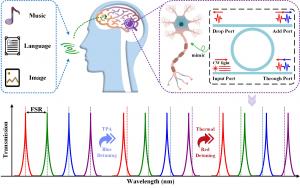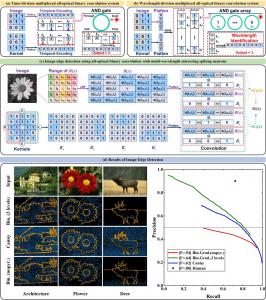All-optical digital logic and neuromorphic intelligent computing based on wavelength auxiliary & competition
Such passive photonic neurons and networks promise access to the high transmission speed and low power consumption inherent to optical systems.
CHENGDU, SICHUAN, CHINA, October 9, 2025 /EINPresswire.com/ -- Traditional artificial neural networks, exemplified by large-scale models such as ChatGPT, have been widely applied across various domains. However, these models commonly suffer from low computational speed, high latency, and significant energy consumption during training and inference, posing critical bottlenecks to the further advancement of artificial intelligence.Photonic spiking neural networks, as a novel architecture integrating neuromorphic computing and photonic technologies, combine the spatiotemporal encoding and event-driven nature of spiking neural networks with the advantages of photonics, including ultra-high bandwidth, ultra-low power consumption, and large-scale parallel processing. This architecture represents a promising direction for achieving breakthroughs in intelligent computing.
Microring resonators, with their compact structure and low static power consumption, are considered ideal devices for emulating neuron-like dynamic behaviors, enabling the realization of photonic spiking neurons for brain-inspired intelligent computing. However, there has been no systematic investigation into multi-wavelength microring-based spiking neurons, nor reports on their use for implementing complete digital logic operations and related intelligent computing applications highlighting a critical need for further exploration.
This section should explain the strategies, results, importance and contribution of your work in a broader context in the third person. In terms of words and expression, please consider how to attract both specialist and non-specialist scientific audience.
Recently, Prof. Kun Qiu and Prof. Ning Jiang from the University of Electronic Science and Technology of China proposed, for the first time, an all-optical spiking neuron model based on a multi-wavelength auxiliary and competition mechanism in microring resonators. This model reveals the nonlinear spiking dynamics exhibited by microring resonators under wavelength-division multiplexing, and successfully enables the implementation of complete all-optical digital logic operations. Building upon this foundation, the neuromorphic intelligent computing capabilities of the proposed photonic neuron were further demonstrated through a case study on image edge detection.
Figure 1 presents the architecture of the proposed multi-wavelength photonic spiking neuron based on microring resonators. Utilizing wavelength-division multiplexing, optical pulses at distinct wavelengths are simultaneously coupled into the microring. Within the cavity, the combined influence of free-carrier dispersion and thermo-optic effects gives rise to multi-wavelength auxiliary and competition spiking dynamics, enabling binary spike-based representations of Boolean logic.
By exploiting the spiking dynamics of microring neurons and integrating both intensity and temporal encoding schemes, three fundamental all-optical digital logic gates AND, OR, and NOT were successfully realized. Building upon these basic gates through cascading, more complex logic functions including NAND, NOR, and XOR were implemented. Furthermore, a full adder, serving as a key component of the arithmetic logic unit in all-optical computing architectures, was constructed to validate the approach’s potential for large-scale digital logic operations. The corresponding results are shown in Figure 2.
Building on the previously demonstrated logic operations, the research team validated the neuromorphic computing capability of the proposed photonic spiking neuron through a representative application, image edge detection based on binary convolution, as illustrated in Figure 3. All-optical logic gates, constructed from microring-based spiking neurons, were employed to perform binary convolution operations. A binary gradient estimation algorithm was used to extract image gradients, successfully enabling edge identification.
This work, entitled 'All-optical digital logic and neuromorphic computing based on multi-wavelength auxiliary and competition in a single microring resonator', was published in Opto-Electronic Science, Early View section. The research was supported by the National Natural Science Foundation of China under Grant Nos. 62171087 and 62475036.
About the Authors:
Prof. Kun Qiu, Prof. Ning Jiang, and their team at the University of Electronic Science and Technology of China have long been engaged in research on photonic computing, laser chaos technology, optical switching, and high-speed optical transmission, etc. The team has been awarded the Class-2 Prize of National Technical Invention, along with 10 provincial or ministerial awards for their contributions to development of science and technology. They have established advanced experimental platforms for high-precision laser fabrication, optoelectronic integration, high-speed optical transmission, optical switching, and secure optical communication, etc. To date, the group has published over 100 papers in leading domestic and international optics journals, including Opto-Electronic Advances, Photonics Research, and Journal of Lightwave Technology (with 2 ESI Highly Cited Papers), as well as more than 60 conference papers. Additionally, the team holds over 20 granted national invention patents and has successfully undertaken and completed over 20 major national projects.
Read the full article here: https://www.oejournal.org/oes/article/doi/10.29026/oes.2025.250003
Andrew Smith
Charlesworth
+44 7753 374162
marketing@charlesworth-group.com
Visit us on social media:
LinkedIn
YouTube
Other
Legal Disclaimer:
EIN Presswire provides this news content "as is" without warranty of any kind. We do not accept any responsibility or liability for the accuracy, content, images, videos, licenses, completeness, legality, or reliability of the information contained in this article. If you have any complaints or copyright issues related to this article, kindly contact the author above.



